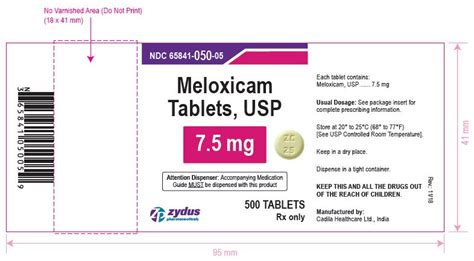Intro
Discover what Meloxicam is, a nonsteroidal anti-inflammatory drug (NSAID) used to treat pain, inflammation, and arthritis, with information on its uses, side effects, and interactions, as a COX-2 inhibitor for osteoarthritis and rheumatoid arthritis relief.
Meloxicam is a type of nonsteroidal anti-inflammatory drug (NSAID) that is commonly used to treat pain, inflammation, and stiffness in conditions such as osteoarthritis, rheumatoid arthritis, and ankylosing spondylitis. It is also used to manage pain and inflammation in other conditions, such as tendinitis and bursitis. Meloxicam works by blocking the production of prostaglandins, which are chemicals in the body that cause pain and inflammation.
The importance of meloxicam lies in its ability to provide relief from chronic pain and inflammation, which can significantly impact a person's quality of life. Chronic pain and inflammation can make everyday activities difficult, and can also lead to depression, anxiety, and other mental health issues. By reducing pain and inflammation, meloxicam can help people to regain their independence, mobility, and overall well-being.
In addition to its therapeutic benefits, meloxicam is also a relatively safe and well-tolerated medication, especially when compared to other NSAIDs. It has a lower risk of gastrointestinal side effects, such as stomach ulcers and bleeding, which are common with other NSAIDs. This makes meloxicam a popular choice among healthcare providers and patients alike.
What is Meloxicam Used For

Meloxicam is used to treat a variety of conditions, including osteoarthritis, rheumatoid arthritis, ankylosing spondylitis, tendinitis, and bursitis. It is also used to manage pain and inflammation in other conditions, such as menstrual cramps, sprains, and strains. Meloxicam can be used to treat both acute and chronic pain, and is often prescribed for long-term use to manage chronic conditions.
In osteoarthritis, meloxicam can help to reduce pain and inflammation in the joints, making it easier to move and perform daily activities. In rheumatoid arthritis, meloxicam can help to reduce inflammation and slow down the progression of the disease. In ankylosing spondylitis, meloxicam can help to reduce pain and stiffness in the spine and other joints.
How Does Meloxicam Work
Meloxicam works by blocking the production of prostaglandins, which are chemicals in the body that cause pain and inflammation. Prostaglandins are produced by an enzyme called cyclooxygenase (COX), which has two forms: COX-1 and COX-2. Meloxicam selectively blocks the production of COX-2, which is the form of the enzyme that is responsible for producing prostaglandins that cause pain and inflammation.By blocking the production of COX-2, meloxicam reduces the amount of prostaglandins in the body, which in turn reduces pain and inflammation. Meloxicam also has anti-inflammatory properties, which can help to reduce swelling and redness in affected areas.
Benefits of Meloxicam

The benefits of meloxicam include its ability to provide relief from chronic pain and inflammation, its relatively safe and well-tolerated profile, and its convenience of use. Meloxicam is available in a variety of formulations, including tablets, capsules, and injectables, which can be tailored to an individual's specific needs.
Some of the key benefits of meloxicam include:
- Relief from chronic pain and inflammation
- Reduced risk of gastrointestinal side effects
- Convenience of use
- Availability in a variety of formulations
- Ability to manage both acute and chronic pain
Side Effects of Meloxicam
While meloxicam is generally well-tolerated, it can cause side effects in some people. Common side effects of meloxicam include: * Stomach upset * Diarrhea * Nausea * Headache * DizzinessLess common side effects of meloxicam include:
- Stomach ulcers
- Bleeding
- Allergic reactions
- Liver damage
- Kidney damage
It is essential to follow the recommended dosage and usage instructions for meloxicam to minimize the risk of side effects.
How to Take Meloxicam

To take meloxicam safely and effectively, it is essential to follow the recommended dosage and usage instructions. Here are some general guidelines:
- Take meloxicam with food to reduce the risk of stomach upset
- Take the recommended dose at the same time each day
- Do not take more than the recommended dose
- Do not take meloxicam for longer than recommended
- Tell your healthcare provider about any other medications you are taking
It is also essential to monitor your condition while taking meloxicam and to report any changes or concerns to your healthcare provider.
Interactions with Other Medications
Meloxicam can interact with other medications, including: * Blood thinners * Diuretics * Beta blockers * ACE inhibitors * LithiumIt is essential to tell your healthcare provider about any other medications you are taking before starting meloxicam.
Precautions and Warnings

While meloxicam is generally safe and well-tolerated, there are some precautions and warnings to be aware of:
- Meloxicam can increase the risk of stomach ulcers and bleeding, especially in people who are over 65 or have a history of stomach problems
- Meloxicam can increase the risk of heart attack and stroke, especially in people who have a history of heart disease
- Meloxicam can cause liver and kidney damage, especially in people who have a history of liver or kidney disease
- Meloxicam can cause allergic reactions, especially in people who are allergic to NSAIDs
It is essential to follow the recommended dosage and usage instructions for meloxicam and to monitor your condition while taking the medication.
Special Considerations
There are some special considerations to be aware of when taking meloxicam, including: * Pregnancy and breastfeeding: Meloxicam should be used with caution in pregnant and breastfeeding women, as it can pass into breast milk and may affect the developing fetus. * Children: Meloxicam should not be given to children under the age of 18, as it has not been studied in this age group. * Older adults: Meloxicam should be used with caution in older adults, as it can increase the risk of stomach ulcers and bleeding.It is essential to discuss any special considerations with your healthcare provider before starting meloxicam.
What is meloxicam used for?
+Meloxicam is used to treat pain, inflammation, and stiffness in conditions such as osteoarthritis, rheumatoid arthritis, and ankylosing spondylitis.
How does meloxicam work?
+Meloxicam works by blocking the production of prostaglandins, which are chemicals in the body that cause pain and inflammation.
What are the benefits of meloxicam?
+The benefits of meloxicam include its ability to provide relief from chronic pain and inflammation, its relatively safe and well-tolerated profile, and its convenience of use.
We hope this article has provided you with a comprehensive overview of meloxicam, including its uses, benefits, and precautions. If you have any further questions or concerns, please don't hesitate to comment below or share this article with others who may find it helpful. Remember to always consult with your healthcare provider before starting any new medication, and to follow the recommended dosage and usage instructions to minimize the risk of side effects.
